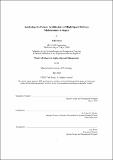| dc.contributor.author | Soeda, Yuki,
S.M.
Massachusetts Institute of Technology. | en_US |
| dc.contributor.other | Massachusetts Institute of Technology. Engineering and Management Program. | en_US |
| dc.contributor.other | System Design and Management Program. | en_US |
| dc.coverage.spatial | a-ja--- | en_US |
| dc.date.accessioned | 2021-10-08T16:59:48Z | |
| dc.date.available | 2021-10-08T16:59:48Z | |
| dc.date.copyright | 2020 | en_US |
| dc.date.issued | 2020 | en_US |
| dc.identifier.uri | https://hdl.handle.net/1721.1/132866 | |
| dc.description | Thesis: S.M. in Engineering and Management, Massachusetts Institute of Technology, System Design and Management Program, May, 2020 | en_US |
| dc.description | Cataloged from the official version of thesis. | en_US |
| dc.description | Includes bibliographical references (pages 86-88). | en_US |
| dc.description.abstract | Most of Japan's railway infrastructure is decades old and requires efficient maintenance. However, pursuing efficiency is not easy because of strict safety requirements and many stakeholders that need to be considered. This study uses the ARIES framework to discuss the strategies that Japanese railway companies should take to achieve sustainable growth by maintaining safety and improving efficiency at the same time from the perspective of organizational design. The study uses the Central Japan Railway Company (CJR) as a representative of the industry. Firstly, the external environment of the organization is analyzed using seven important ecosystem factors, and stakeholder analysis identifies the key stakeholders and their values. In addition, the internal situation of the organization is investigated through eight view elements. The results of these analyses show that while CJR has strengths in infrastructure, a safety-oriented organizational culture, and specialized processes for railway operations, it has weaknesses in monitoring information and flexibility of decision-making, which may make it difficult to respond to changes in the external environment, such as population decline and the impact of COVID-19. These findings are incorporated into SWOT analysis and X-matrix analysis, and the possible strategies for CJR are discussed. As a result, six concepts and three alternative architectures based on these concepts are generated. Each alternative architecture is evaluated based on eight criteria, including safety, efficiency, and flexibility. The evaluation finds that aiming for a technology and data-oriented organization may be the most reasonable option for CJR. The study also suggests that a small, cross-functional team should lead the transformation and confirms the robustness of the selected architecture in three possible scenarios. Lastly, a feasible implementation plan with detailed architecture and alignment of internal metrics and processes is proposed. | en_US |
| dc.description.statementofresponsibility | by Yuki Soeda. | en_US |
| dc.format.extent | 88 pages | en_US |
| dc.language.iso | eng | en_US |
| dc.publisher | Massachusetts Institute of Technology | en_US |
| dc.rights | MIT theses may be protected by copyright. Please reuse MIT thesis content according to the MIT Libraries Permissions Policy, which is available through the URL provided. | en_US |
| dc.rights.uri | http://dspace.mit.edu/handle/1721.1/7582 | en_US |
| dc.subject | Engineering and Management Program. | en_US |
| dc.subject | System Design and Management Program. | en_US |
| dc.title | Analyzing the future architecture of high-speed railway maintenance in Japan | en_US |
| dc.type | Thesis | en_US |
| dc.description.degree | S.M. in Engineering and Management | en_US |
| dc.contributor.department | Massachusetts Institute of Technology. Engineering and Management Program | en_US |
| dc.identifier.oclc | 1263347135 | en_US |
| dc.description.collection | S.M.inEngineeringandManagement Massachusetts Institute of Technology, System Design and Management Program | en_US |
| dspace.imported | 2021-10-08T16:59:48Z | en_US |
| mit.thesis.degree | Master | en_US |
| mit.thesis.department | SysDes | en_US |
